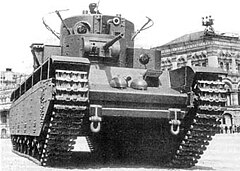T-35
| T-35 | |
|---|---|

A T-35 in Red Square, 1 May 1935
|
|
| Type | Heavy tank |
| Place of origin | Soviet Union |
| Service history | |
| In service | 1935–1941 |
| Used by | Soviet Union |
| Wars | World War II |
| Production history | |
| Designer | OKMO Tank Design Bureau |
| Designed | 1930–32 |
| Manufacturer | KhPZ |
| Produced | 1933–38 |
| No. built | 61 |
| Variants | T-35B |
| Specifications | |
| Weight | 45 tonnes |
| Length | 9.72 m |
| Width | 3.20 m |
| Height | 3.43 m |
| Crew | 11 |
|
|
|
| Armor | 11–30 mm |
|
Main
armament |
76.2 mm gun model 27/32 |
|
Secondary
armament |
2 × 45 mm 20k guns, 5 or 6 × 7.62 mm DT machine guns |
| Engine | 12-cyl. petrol Mikulin M-17M 500 hp (370 kW) |
| Power/weight | 11 hp/tonne |
| Suspension | Coil spring |
|
Operational
range |
150 km |
| Speed | 30 km/h |
The T-35 was a Soviet multi-turreted heavy tank of the interwar period and early Second World War that saw limited production and service with the Red Army. It was the only five-turreted heavy tank in the world to reach production, but proved to be slow and mechanically unreliable. Most of the T-35 tanks still operational at the time of Operation Barbarossa were lost due to mechanical failure rather than enemy action.
Outwardly, it was large; but internally, the spaces were cramped with the fighting compartments separated from each other. Some of the turrets obscured the entrance hatches.
The T-35 was developed by the OKMO design bureau of the Bolshevik Factory, which began work on a heavy tank in 1930. Two teams developed separate designs. The team headed by German engineer Grotte worked on the 100-ton four-turreted TG-5 tank, armed with a 107 mm naval gun, using pneumatic servo-controls and pneumatic suspension. This project was later cancelled.
The concept of large, multi-turreted breakthrough tanks was favoured by several European armies in the 1920s and 1930s. Designs existed in Britain, France, and Germany for such vehicles. The second OKMO team, headed by N. Tsiets, worked on a tank inspired by the British Vickers A1E1 Independent.
By July 1932, a prototype of a 35-ton tank with a 76.2 mm tank gun was completed. The first prototype was further enhanced with four smaller turrets, two with 37 mm guns and two with machine guns. This first prototype had severe defects in its transmission and was considered too complex and expensive for mass production. Work on it was therefore stopped and a new simpler prototype was built.
This new prototype received a new engine, new gearbox and improved transmission. The decision was also made to standardise the turrets used on the T-35 with those employed on the T-28, a triple-turreted medium tank. The small machine-gun turrets were identical on the two tanks. The large main turret housing the 76.2 mm gun was nearly identical, but those used on the T-28 had an additional, rear-firing machine gun.
On 11 August 1933, the T-35 was accepted for production. Engineering was shifted to the Kharkov Locomotive Factory, and two batches of ten vehicles were completed.
...
Wikipedia
